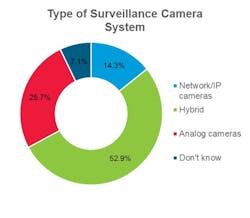Video Surveillance in Public Transportation
Video surveillance is a very common technology used in public transportation. It is largely used for security purposes, although it also has other uses and is a solution highly valued by staff and passengers. UITP, together with Axis Communications, conducted a survey among public transport organizations to get an understanding of the various aspects of video surveillance in public transportation, particularly for security. The survey was conducted between April and September 2015.
The survey results are based on input from 74 responders in 30 countries. Most responders come from Western Europe, followed by Asia Pacific, Central and Eastern Europe, North America and Latin America. Most responders, 83.8 percent, are from developed countries according to the OECD Market Classification.
The majority of responders are public transport operators, 73 percent, some public transport authorities were also taking part along with a very small number of responders are infrastructure owner/managers or separate station owners.
Surveillance Equipment
Almost all responders have video surveillance installed today, analogue or network/IP cameras. About two thirds of respondents report that they have network/IP cameras as part of their surveillance systems and a little over half of the responders have a hybrid surveillance system, consisting of a mix of analogue and network/IP cameras in place. About a quarter of responders still is entirely relying on analogue cameras.
In the next year, 74.3 percent of responders have investment plans for new surveillance systems. Of those organizations, 85.3 percent will consider network/IP cameras. This clearly shows a preference for network cameras for the future. However, it is important to note that legacy analogue cameras will clearly still have an important presence in public transport systems for the foreseeable future. Even without installing network/IP cameras, analogue systems can be converted to network/IP systems by, for example, the use of video encoders.
As for the barriers of investing in new technology, responders report “other priorities within their organization” (30.4 percent) and “difficulty in getting funding” (20.3 percent) as the two largest categories of obstacles. Approximately three quarters of responders that replied “No clear business case” have analogue cameras in their surveillance systems today.
Surveillance Usage
Cameras are currently installed in practically all parts of public transport systems, at stations (81.0 percent), onboard rolling stock (75.6 percent) and at depots and rail yards (70.2 percent). Video footage can either be recorded, viewed in real-time, or both. The majority of recordings from stations will be from public areas such as public station areas and platforms, areas where large numbers of customers gather. Depots and rail yards do not typically have passenger presence, however recording here is popular due to the fact that it is where valuable assets are stored.
In general more than half (52.7 percent) of responders reported that video surveillance would be installed onboard rolling stock in the coming 12 months which suggests that onboard cameras will become more common. Other parts of the system will also see more cameras installed and only a quarter of responders do not plan any investments in video surveillance at all in the next 12 months.
Real-time usage of video surveillance is viewing video live (monitoring) or using live video as a tool during an incident. Additionally video analytics can be added to support the detection of an incident. Today, real-time usage of video footage is noticeably higher in static locations, such as stations, depots and rail yards. Less common is real-time surveillance onboard rolling stock with 27 percent of responders using this.
The vast majority of respondents is using video footage for investigation and evidence collection. Image quality is a key criterion for video surveillance in this case to ensure any evidence is valid in court. It is interesting to note, however, that 67.6 percent of respondents already use video images for detection purposes as well.
Sharing live video with other parties, such as police or other authorities, is very common. The sharing of live video is most frequent with operational control centers followed by central security centers and stations control centers. Police organizations are also a video sharing partner. In some countries a specific transport police force is present. If results are viewed looking at sharing with all police organizations, dedicated to transport or not, the consolidated data on video sharing is in parity with the previous group of control centers.
Legal Limitations
The legal situations regarding video surveillance vary widely from country to country. Almost 40 percent of responders reported that surveillance monitoring is a legal requirement. Where it is not a legal requirement, it may still be further regulated- e.g. surveillance outside the property of the public transport system is not allowed or requires a special permit. For about 20 percent of respondents, permits for surveillance outside of its property are included in their granted permissions.
In terms of the recording of video, all respondents report that the recording of video footage is allowed, but almost all of those are subject to additional regulation: limited storage/retention time (ranging from 48 hours to 100 days) at 41.2 percent, certain areas only at 13.4 percent, for police usage only at 11.3 percent and other regulations. Only 10.4 percent of responders have no legal limitations at all.
Using sound input with surveillance is an effective addition during incidents and can add additional evidence material. At the same time, it is sometimes considered more invasive of personal integrity. Sound input is permitted for about two thirds of responders, with no limitations for 12.5 percent of those. However, for the vast majority, there are legal regulations in terms of usage: storage and retention time (40.7 percent), certain areas only (17.5 percent) and police usage only (7.5 percent). For approximately a third, sound input is not allowed at all.
When video surveillance is used as formal evidence in court, the quality of the material is important. For 66.7 percent of responders the quality of video to be valid evidence in court is regulated in some way, mainly either by law or by police directives. This gives assurance to the public transport organization that video can be used as evidence. Different standards exist in different parts of the world in terms of the quality of images for court use. Local regulations on quality of image and/or sound for court use are widespread and very helpful in maximizing the added-value of surveillance systems. Regulations are also in place to protect the privacy of citizens and staff and this is essential in many cultures for such systems to be accepted.
The Value of Surveillance
For the vast majority of respondents, it is the increase of actual and perceived security, as well as minimizing, deterring and managing various types of criminality, which are the biggest gains with all three categories scoring above 70 percent. A third of responders mentioned helping investigations into crimes, injuries, suicides and accidents, including disproving false claims.
Reducing fare evasion was only relevant for a small minority (9.5 percent).
The most common problem that public transport operators experience is the difficulty in monitoring the large number of cameras in the system. Further problems concern a wide variety of issues including poor image quality, technical issues with the system, resource intensive or requiring special competences, and the fact that present system architecture does not allow for easy expansion of the system. Less than 20 percent reported no challenges or negative effects at all.
In terms of image quality, it is interesting to note that 54.5 percent of responders with analogue systems reported poor image quality as a problem, compared to only 16.7 percent of responders with network/IP systems. However, this observation is not statistically sound due to too few responses from IP-only networks.
Staff is generally very positive towards the use of video surveillance with 78.3 percent indicating positive reactions from staff, especially when usage of the system is well communicated to employees. This goes up to 85.5 percent when including neutral reactions from staff. Not all responders measure the reaction of staff in this matter but of those that do, none reported a negative reaction.
In terms of passenger attitudes, the picture is similar. Almost two thirds eport positive reactions, with this figure going up to 75 percent when including neutral reactions. Of the 75 percent of responders who systematically measure passenger reactions in this area, none reported negative attitudes from passengers.
Analytics
The awareness of different video analytics features in general is very high:
• About 80 percent of respondents are familiar with intrusion detection, perimeter breach and face recognition tools
• About two thirds know about tools to detect rail track access, fire and smoke, left luggage and overcrowding
• Half of the respondents had heard of graffiti behavior detection, ticket gate jumping alerts
• More than one third knew about tools for aggression, tailgaiting and loitering detection
When it comes to the current use of video analytics, some tools clearly stand out, ranging from 6.8 to 25.0 percent of usage among responders: intrusion detection, perimeter breach detection, rail track access detection, fire & smoke detection and graffiti behavior detection.
Future interest in video analytics amongst the responders is high: approximately half of the responders have answered that they are interested in using them moving forward.
• Graffiti behavior, fire & smoke, left luggage and overcrowding detection clearly attract most of the interest
• Perimeter breach, intrusion, face recognition, aggression, rail track access, loitering detection are interesting for about half of the respondents
• Ticket gate jumping and tailgating detection form the last group and are interesting for about 30 percent of public transport operators
Conclusions
What this data can tell us is that there is a clear tendency toward network/IP cameras in terms of future investment and particularly emerging analytics applications for specific issues such as graffiti behavior detection.
On the other hand, legacy analogue cameras will continue to have an important presence in public transport systems for the foreseeable future.
Real-time usage with analytics is also on the rise as public transport systems seek to react to security events as and when they happen, with alerts guiding the operators rather than the impossible task of coping with hundreds of live feeds.
With the reported investments foreseen in real-time, there will be more opportunity for live feeds to be shared with third parties than is reported today. Despite this drive towards real-time network/IP solutions, recorded footage for review purposes is still very helpful and will remain widely used in the foreseeable future.
In terms of regulation, local laws or rules for video to be valid in court is very helpful as it gives assurance that the evidence can be used. Other regulations in terms of usage, storage and so on vary widely from country to country depending on privacy and data protection laws. Laws certainly define the scope of how video surveillance is used in each place but rarely seems to be a barrier for public transport systems.
The survey clearly demonstrates that video surveillance is a widely used technology in public transport, for security but for other purposes too. The survey results point to more interesting conclusions other than those mentioned in this report, however the sample size was not large enough to merit statistically sound statements. A repeat of the survey in the future would enable the tracking of trends and digging deeper into these unsupported findings.
Video surveillance is a solution which is highly valued by staff as well as passengers. Public transport systems clearly intend to invest further in these technologies in the coming years, and the technology has huge potential to assist public transport organizations in real-time. Video surveillance will firmly remain a cornerstone technology in public transportation.
Andrea Soehnchen is the business development manager for UITP.
About the Author

